What is 22q11.2 Deletion Syndrome?
22q11.2 Deletion Syndrome, also known as Velocardiofacial syndrome (VCFS), Shprintzen Syndrome and DiGeorge Syndrome or DiGeorge Sequence is caused by the deletion of a small segment of the long arm of chromosome 22 (specified as 22q11.2 deletion), and is one of the most common genetic disorders in humans- occurring in an estimated 1 in 2,000 births. Despite the involvement of a very specific portion of chromosome 22, there is great variation in the features of this syndrome. None of the problems occur in all cases. ________________________________________________________________________________________________________
What causes 22q11.2 Deletion Syndrome?
It is not known why this region of chromosome 22 is prone to become deleted, but this is one of the most frequent chromosome defects in newborns. Deletion 22q11.2 is estimated to occur in one in 2,000 to 4,000 live births. Most of the 22q11.2 deletion cases are new occurrences or sporadic (occurs by chance). However, in about 10 percent of families, the deletion is inherited and other family members are affected or at risk for passing this deletion to their children. The gene is autosomal dominant, therefore, any person who has this deletion has a 50 percent chance of passing the deletion to a child. For this reason, whenever a deletion is diagnosed, both parents are offered the opportunity to have their blood studied to look for this deletion. Approximately 10 percent of individuals who have the features of VCFS/DiGeorge do not have a deletion in the chromosome 22q11 region.
What are some common features of 22q11.2 Deletion Syndrome?
-palatal abnormalities (such as cleft lip and/or palate, submucous cleft being most common)
- feeding difficulties
-conotruncal heart defects (e.g., truncus arteriosus, Tetralogy of Fallot, interrupted aortic arch, ventricular septal defects, vascular rings)
-hearing loss or abnormal ear exams
-genitourinary anomalies (absent or malformed kidney)
-hypoparathyroidism and hypocalcemia (low blood calcium levels)
-IQs are generally in the low average, or 70 to 90 range
-increased risk for psychiatric disorders in adults (e.g., schizophrenia, bipolar disorder)
-immunologic dysfunction (an immune system which does not work properly due to abnormal T-cells, causing frequent infections)
Click Here for the VCFS / 22q11.2 Factsheet
* Information taken from the Velo Cardio Facial Syndrome Educational Foundation (now defunct) and The International 22Q Foundation www.22q.org
Velo-Cardio- Facial-Syndrome (VCFS) Educational Foundation, Inc.
The Foundation is an international not-for-profit organization dedicated to providing support and information to individuals who are affected by Velo-Cardio-Facial syndrome, their families, physicians and other practitioners.
22Q Central - Care to be aware
22q Central is a 501(c)(3) non-profit organization with the goal of promoting awareness and education regarding a common, yet many times overlooked, genetic disorder known as 22q11.2 Deletion Disorder, DiGeorge Syndrome, VCFS (velo-cardio-facial syndrome) and others. Parents
22Q The International 22q11.2 Deletion Syndrome Foundation, Inc.
22q is a non-profit organization that was founded by parents in an effort to bring awareness and support for this rare and under recognized condition. The organization is built on the belief that through identification, appropriate treatment, research and education there can be a better quality of life for those living with this condition and their families, improved medical care for patients with this condition and one day a cure for the 22q11.2 deletion.
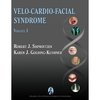 Velo-Cardio-Facial Syndrome, volume 1 by Robert J. Shprintzen and Karen J. Golding-Kushner (Plural Publishing, 2008)
Velo-Cardio-Facial Syndrome, volume 1 by Robert J. Shprintzen and Karen J. Golding-Kushner (Plural Publishing, 2008)
Velo-Cardio-Facial Syndrome, volume1 is a comprehensive text describing the full range of clinical findings associated with VCFS. The text is accompanied by a DVD that contains 19 videos that compliment the text and more than 110 figures, many in color, including growth charts specific to VCFS. Chapter 1 details the history of VCFS, its delineation, and the current interest in this important syndrome. Chapter 2 details the phenotypic spectrum of VCFS, detailing 190 clinical features of the syndrome with 72 figures associated with the written descriptions. Chapter 3 discusses the genetics of VCFS in straightforward and simple language that is suitable for all readers. Included in Chapter 3 is a description of how the deletion occurs and why it can account for the expansive clinical spectrum. Chapter 4 is a guide for the clinical management of VCFS including triage systems that are specific to the natural history of the syndrome. Chapter 5 provides an important discussion of growth, weight gain, and feeding in VCFS and includes the first growth chart specific to the syndrome. Feeding techniques are discussed, as are the reasons for feeding difficulties in VCFS. The aim of this chapter is to avoid stress and medical dependency that can be better understood based on the growth curves provided.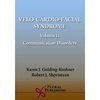 Velo-cardio-facial Syndrome volume 2: Treatment of Communication Disorders by Karen J. Golding-Kushner and Robert J. Shprintzen (Plural Publishing, 2011)
Velo-cardio-facial Syndrome volume 2: Treatment of Communication Disorders by Karen J. Golding-Kushner and Robert J. Shprintzen (Plural Publishing, 2011)
Volume II of this set opens with information of aspects of speech and language and the difficulties most often associated with VCFS. Authors also consider how these difficulties interact with each other. Chapter two describes the aspects of articulation and resonance, how they are best evaluated, and on surgical management. In Chapter three, general principles are outlined on how to make articulation therapy successful for children with cleft palate, VCFS, or both, many of which apply to language therapy and other behaviors, as well. The last chapter offers insights into prevention of the abnormal articulation patterns that tend to develop and how to guide children through stages of language development.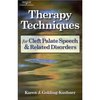 Therapy Techniques for Cleft Palate Speech and Related Disorders, A book focusing on the treatment of speech disorders associated with VCFS is available from Amazon and other sources. Authored by Karen J. Golding-Kushner, Ph.D., the volume book is the outcome of a meeting by a consensus panel of the leading experts in treating these disorders. That meeting was supported in part by a grant from the Educational Foundation in response to the recognized need for a book that detailed speech therapy approaches in children with VCFS. There is one entire chapter devoted specifically to VCFS and similar genetic disorders. Available from Amazon for approximately $65.00.
Therapy Techniques for Cleft Palate Speech and Related Disorders, A book focusing on the treatment of speech disorders associated with VCFS is available from Amazon and other sources. Authored by Karen J. Golding-Kushner, Ph.D., the volume book is the outcome of a meeting by a consensus panel of the leading experts in treating these disorders. That meeting was supported in part by a grant from the Educational Foundation in response to the recognized need for a book that detailed speech therapy approaches in children with VCFS. There is one entire chapter devoted specifically to VCFS and similar genetic disorders. Available from Amazon for approximately $65.00.
 MISSING GENETIC PIECES: Strategies for Living with VCFS, The Chromosome 22q11
MISSING GENETIC PIECES: Strategies for Living with VCFS, The Chromosome 22q11
Deletion", written by Ms. Sherry Gomez of Arizona: A comprehensive HANDBOOK for
Parents, Professionals and Anyone wanting to know about Chromosome 22 Deletion
(22q11) and its dynamics. Note: A portion of the proceeds from this book is being donated
to the VCFS Educational Foundation, Inc.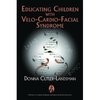 Practical Handbook for Educating Children with Velo-Cardio-Facial Syndrome and Other Developmental Disabilities by Donna Landsman, the person who has lectured more about education and VCFS than any other person in the world. Available on advance order from Amazon.com for $55.00.
Practical Handbook for Educating Children with Velo-Cardio-Facial Syndrome and Other Developmental Disabilities by Donna Landsman, the person who has lectured more about education and VCFS than any other person in the world. Available on advance order from Amazon.com for $55.00.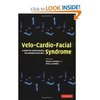 Velo-cardio-facial Syndrome: A Model for Understanding Microdeletion Disorders, Edited by Kieran C. Murphy Education and Research Centre, Royal College of Surgeons of Ireland, Peter J. Scambler Institute of Child Health, University College London.
Velo-cardio-facial Syndrome: A Model for Understanding Microdeletion Disorders, Edited by Kieran C. Murphy Education and Research Centre, Royal College of Surgeons of Ireland, Peter J. Scambler Institute of Child Health, University College London.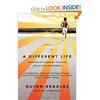 A Different Life: Growing Up Learning Disabled and Other Adventures by Quinn Bradlee
A Different Life: Growing Up Learning Disabled and Other Adventures by Quinn Bradlee
Born With a Hole in His Heart, Quinn Bradlee suffered from a battery of illnesses-seizures, migraines, fevers-from an early age. But it wasn't until he was fourteen that Bradlee was correctly diagnosed with Velo-Cardio-Facial Syndrome (VCFS), a wide-spread, little-understood disorder that causes a range of physical ailments and learning disabilities.